Why Native Plants?
Native plants have been making their way into the public consciousness over the past few years. Why is this? Do native plants really matter that much? What do they help? What sort of plants can you include in your landscape? All of these will be answered in today's post. Before we get into the nitty gritty, let's cover the basics.
What does native, invasive, and naturalized mean?
This is important to establish before we go any further. A native plant is one that evolved in an area before humans had the chance to intervene. In other words, it naturally grows in the region. An example is the eastern redbud (Cercis canadensis) which grows from Canada all the way down into Mexico, mainly growing near the east coast though it can grow as far west as Nebraska. That tree has always grown in the Americas; it evolved here.
 Viola rostrata photographed by Gina DellaSalla
Viola rostrata photographed by Gina DellaSalla
Invasive plants, on the other hand, have been introduced into an area and are actively causing harm in one way or another to the local ecosystem or ecology. Typically, they are choking out native species and not allowing them to grow to maturity, if at all. A few examples of invasive species are Japanese knotweed, multiflora rose, English ivy, butterfly bush, Bradford pears and garlic mustard among many others. Garlic mustard (Alliaria petiolata) in particular has an additional trait that makes it double dangerous. It is allelopathic which means it utilizes a chemical that will inhibit the growth of other plants around it,

boosting its own chance of survival. There are plants that are tolerant to this toxic trait in its natural environment, but not in the environments it has invaded. Black walnut (Juglans nigra) also is allelopathic, but there are native plants that can tolerate the specific chemical the trees utilize called juglone or hydroxyjuglone. Native juglone tolerant plants include pawpaws (Asimina triloba), barberry (Berberis spp.) yarrow (Achillea millefolium), Jack in the Pulpit (Arisaema triphyllum), bloodroot (Sanguinaria canadensis) and many more!
Jack in the Pulpit photographed by Gina DellaSalla
Naturalized plants are those who were introduced to a new area but are "playing nice" with the native species. They coexist without choking each other out. They aren't native or invasive. Examples of naturalized plants include dandelions (Taraxacum officinale), daffodils (Narcissus sp.), and Queen Anne's lace (Daucus carota). Naturalized plants can have the potential to become invasive.
With the basics defined, we can move onto what importance the native plants hold.
So what? Why are they important?
Native plants play an integral role to the environment. Even plants we hate like poison ivy (Toxicodendron radicans) provide food and shelter to wildlife. Birds and deer will dine on the berries this plant produces in summer and pollinators will enjoy the nectar the flowers provide in spring. Trees provide a natural air conditioning. Plants are the habitat. Factors like rainfall, soil, moisture, elevation,

etc. may determine what plants can inhabit the area, which will, in turn, determine what food, shelter, and sometimes water is available to the wildlife that lives in the area. Without plants, there is no shelter, no shade, no food. Each individual plant has its own benefits. Let's go through a few examples...
Wood anemone photographed by Gina DellaSalla
Specific plants and their benefits
There are examples of plants that are the sole host plant for specific species. Host plants are plants that an organism lives on and/or off of. Milkweed is a host plant for monarch butterflies, though there are many species of milkweeds. The federally endangered Karner blue butterfly will only lay its eggs on the wild blue lupine (Lupinus perennis). This is the only plant the caterpillars will eat. Turtlehead (Chelone glabra) has been found to have antiparasitic properties for bumblebees; a natural bee pharmacy. Purple prairie clover (Dalea purpurea) is a favorite among the endangered rusty patched bumblebee, as well as many other native bees. At least two butterflies will use this plant as a host for their caterpillars including Reakirt's blue butterfly and the dogface sulfur butterfly. In addition, purple prairie clover is a member of the bean family, Fabaceae. Like most members of this family, the purple prairie clover will fix nitrogen from the air back into the soil, making it more available for other plants. Even grasses play an important role in the ecosystem. Depending on the grass, it could provide shelter from predators, nectar from its flowers, or be an important food source for herbivorous animals.
 Gaywings (Polygala paucifolia) photographed by Gina DellaSalla
Gaywings (Polygala paucifolia) photographed by Gina DellaSalla
With people taking up more and more space and landscaping with plants that serve no purpose to the wildlife and nature that we are a part of, there are fewer and fewer food sources out there. Invasive, exotic plants are "starvation foods" for local wildlife. They are not going to be eaten until there is nothing left of their preferred foods that they recognize, otherwise known as native plants.
What plants can I utilize in my landscape?
There will be a more detailed blog post to follow on this topic, but for now here are a few suggestions. There are plenty of amazing native trees that are criminally underutilized in the landscape. Trees will be able to host an incredible amount of individual species when they reach their mature size without taking any substantial damage. A few of my favorite native trees include:
 American Sycamore thetreestore.info
American Sycamore thetreestore.info
American Sycamore (Platanus occidentalis)
The American sycamore is spread across the east coast and into the western United States. They are easy to spot in winter with their characteristic exfoliating bark, revealing a beautiful white bark on the top half of the tree. During summer, they create wonderful cooling shade with their large leaves that turn a stunning golden yellow come fall. As the largest deciduous tree native to America, it can host many species. Many songbirds will eat the seeds this tree produces including the Baltimore oriole, American goldfinch, purple finches and more. Squirrels will use this tree to nest in. Many insects will use this tree as a food source including some members of Lepidoptera, leaf hoppers and rarely beaver will consume the wood. As the tree ages, cavities will form which will be used by several species of birds including owls and wood duck. Bats will also roost in these trees occasionally.
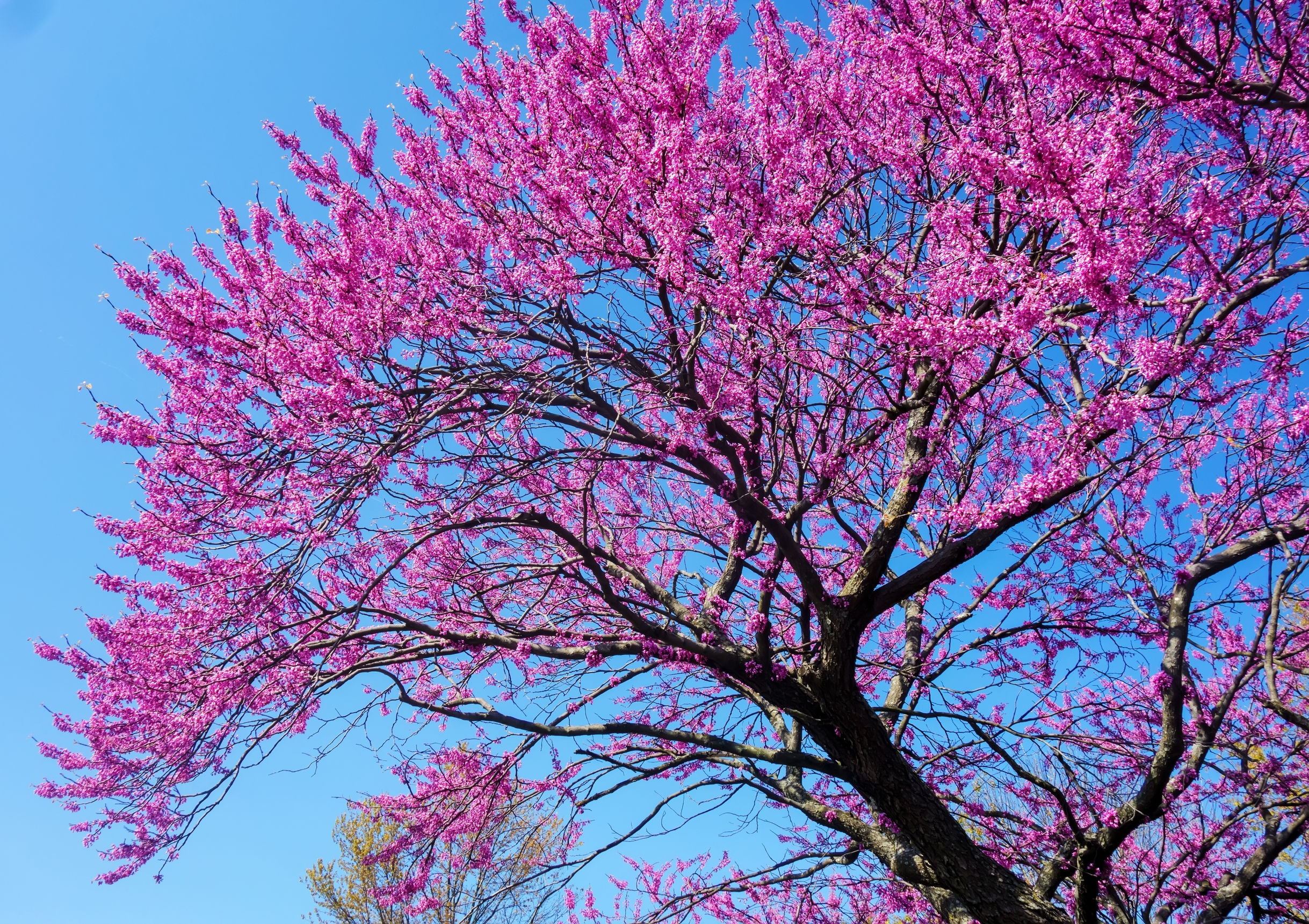 Eastern Redbud www.mymasterplan.com
Eastern Redbud www.mymasterplan.com
Eastern Redbud (Cercis canadensis)
The eastern redbud is a member of Fabaceae, the bean family. Though, unlike its cousins, it lacks the nodules and bacteria found on the roots of other legumes that fix atmospheric nitrogen back into the soil. This doesn't mean it lacks value as a native plant! The recognizable pinkish purple contain ample amounts of pollen and nectar, making it invaluable to pollinators. Bumblebees, hummingbirds, as well many other native bees will frequent these flowers in early spring. Several members of Lepidoptera will lay their eggs on this plant. In addition to being beneficial to the pollinators, both the flowers and the bean-like seed pods are edible to people. This tree will stay small, growing around 15-30 feet tall, making it perfect for the front lawn!
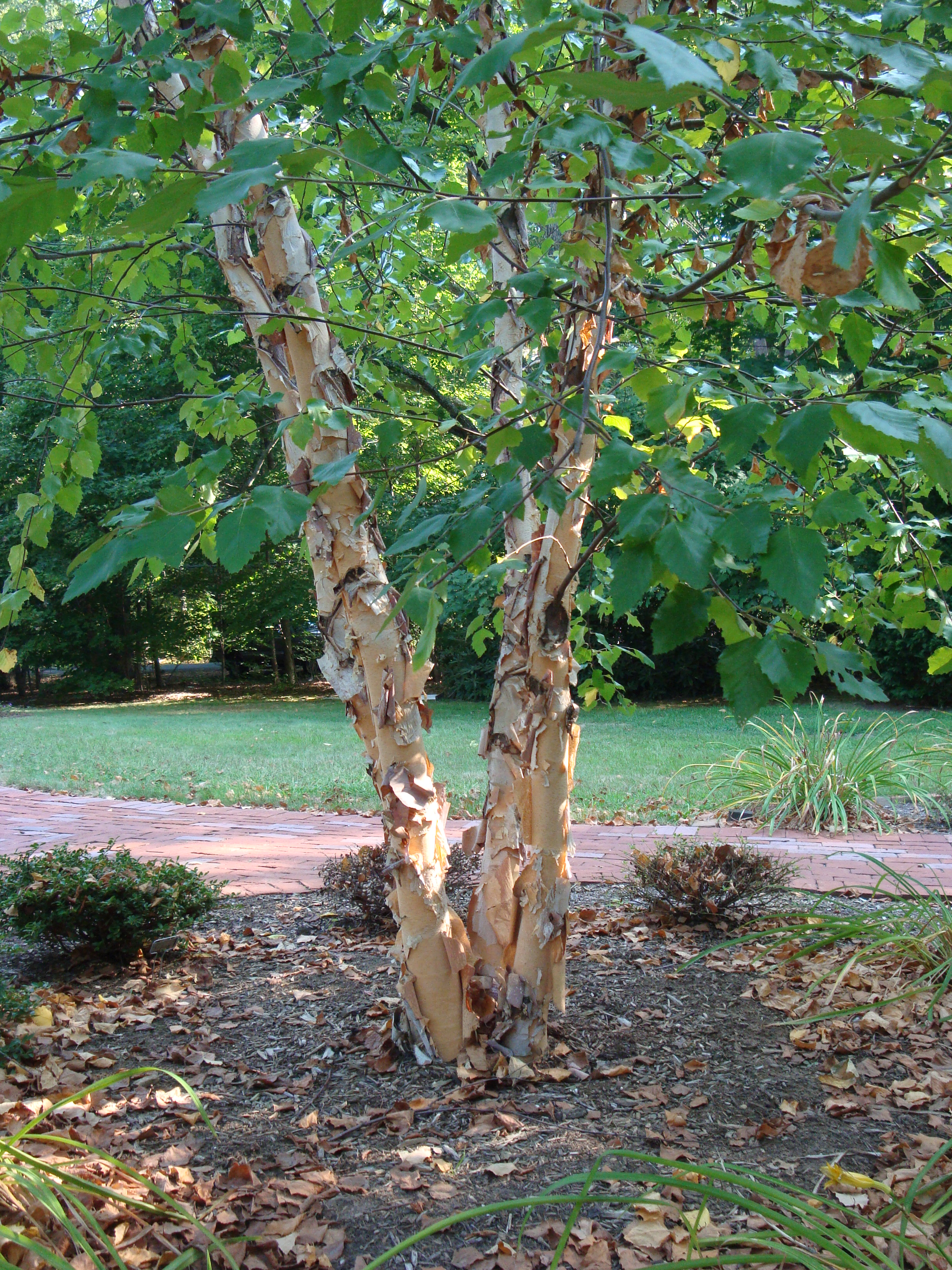 River Birch www.rutgersln.com
River Birch www.rutgersln.com
River Birch (Betula nigra)
River birch is often used in landscapes to provide winter interest with its unique, peeling bark. As the name suggests, it is uniquely suited for wetter soils, like those found along rivers and near ponds. Birch trees are quite valuable, as this tree provides a buffet for wildlife. Mourning cloak, dreamy duskywing, and eastern tiger swallowtail butterflies use this as a host plant for their caterpillars. Songbirds and squirrels will eat the seeds and male flowers, and gamebirds will also dine on the seeds. White tailed deer will eat the young branches in winter when there isn't much else to eat. Even though the deer will nibble on the branches, the tree can tolerate this and is often unaffected.

Pinus strobus photographed by Gina DellaSalla
White Pine (Pinus strobus)
White pine is another tree that hosts a buffet for the wildlife around it. Black bears, small mammals and birds will eat the white pine seeds. The bark is often eaten by beavers, porcupines and small mammals. It is also a host plant for the imperial moth larvae. This tree is tolerant of many soil conditions, making it a great choice for most landscapes. Deer and rabbit may also eat the young branch tips.
Shrubs are another common landscape plant to give a bit of structure to the foundation. Some great native shrub options are:
 Callicarpa americana photographed by Gina DellaSalla
Callicarpa americana photographed by Gina DellaSalla
American Beautyberry (Callicarpa americana)
This shrub is a member of the mint family that will hold onto its attractive purple berries into winter, provided they aren't eaten by wildlife first! The bounteous berries serve a wide variety of animals. They appear in late fall and feed animals from songbirds, foxes, opossum, raccoons, squirrels and more! White tailed deer will munch on the leaves in summer and the berries when the leaves fall. Not to worry though! This plant produces berries on the present year's growth so deer can munch all they want without damaging the display for the following year. They can be pruned down to about a foot above the ground in late winter, so they will be able to tolerate the damage deer cause from grazing.
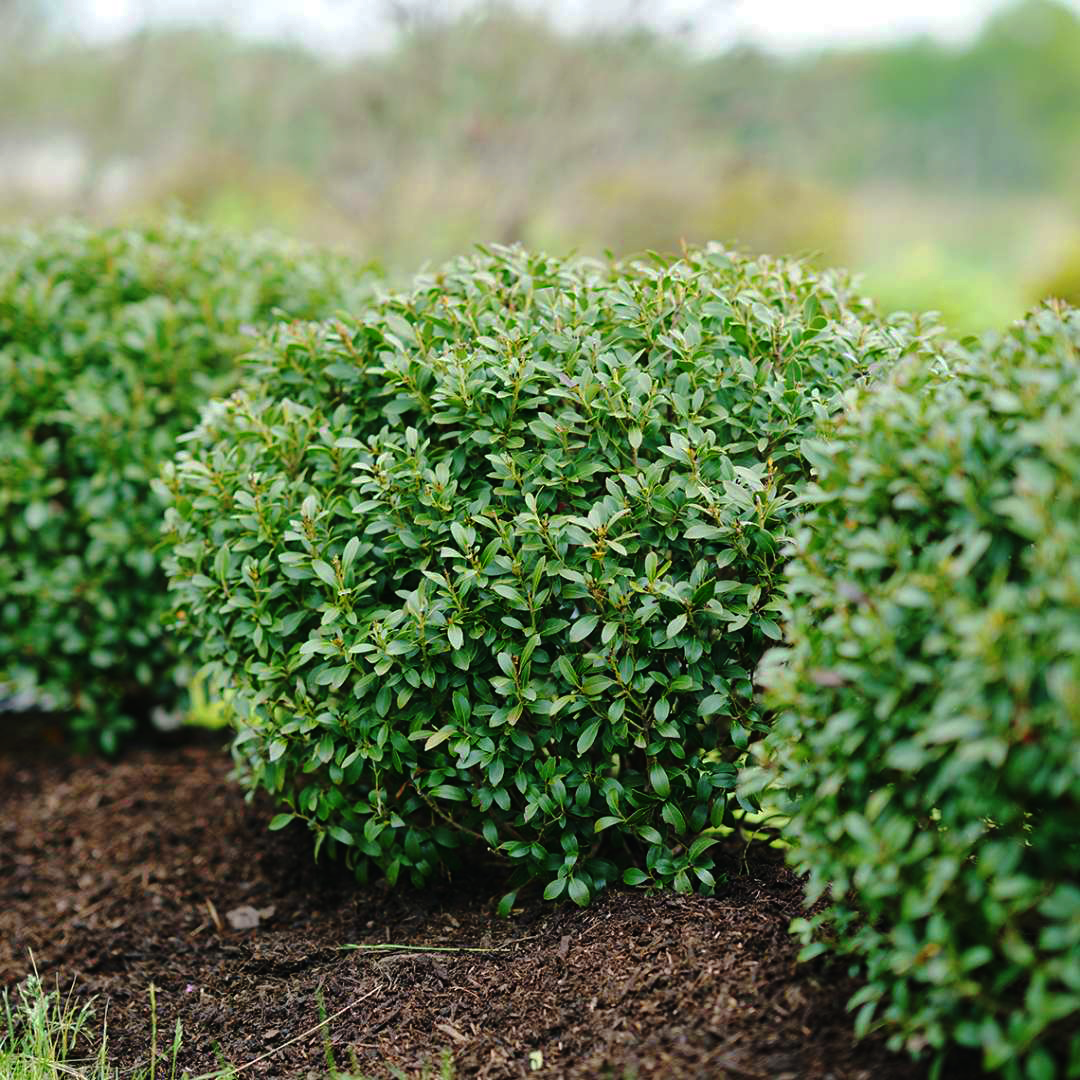 Inkberry Holly www.thetreecenter.com
Inkberry Holly www.thetreecenter.com
Inkberry holly (Ilex glabra)
To the untrained eye, this looks decievingly like a boxwood! They share the traits of being evergreen with similar leaf shape, but the giveaway are the inky black berries that form on the female holly plants. Unlike boxwoods, this plant is native to the east coast of the Americas. Like other hollies, this plant needs a male and female plant in order to make the berries for which it is named. They will remain on the plant for most of winter before several periods of freezing and thawing will make the berries palatable for birds. Henry's elfin butterfly will use this as its host plant. Robins will sometimes eat the berries upon their return from their winter southerly journey. When in bloom, small pollinators will visit the flowers.
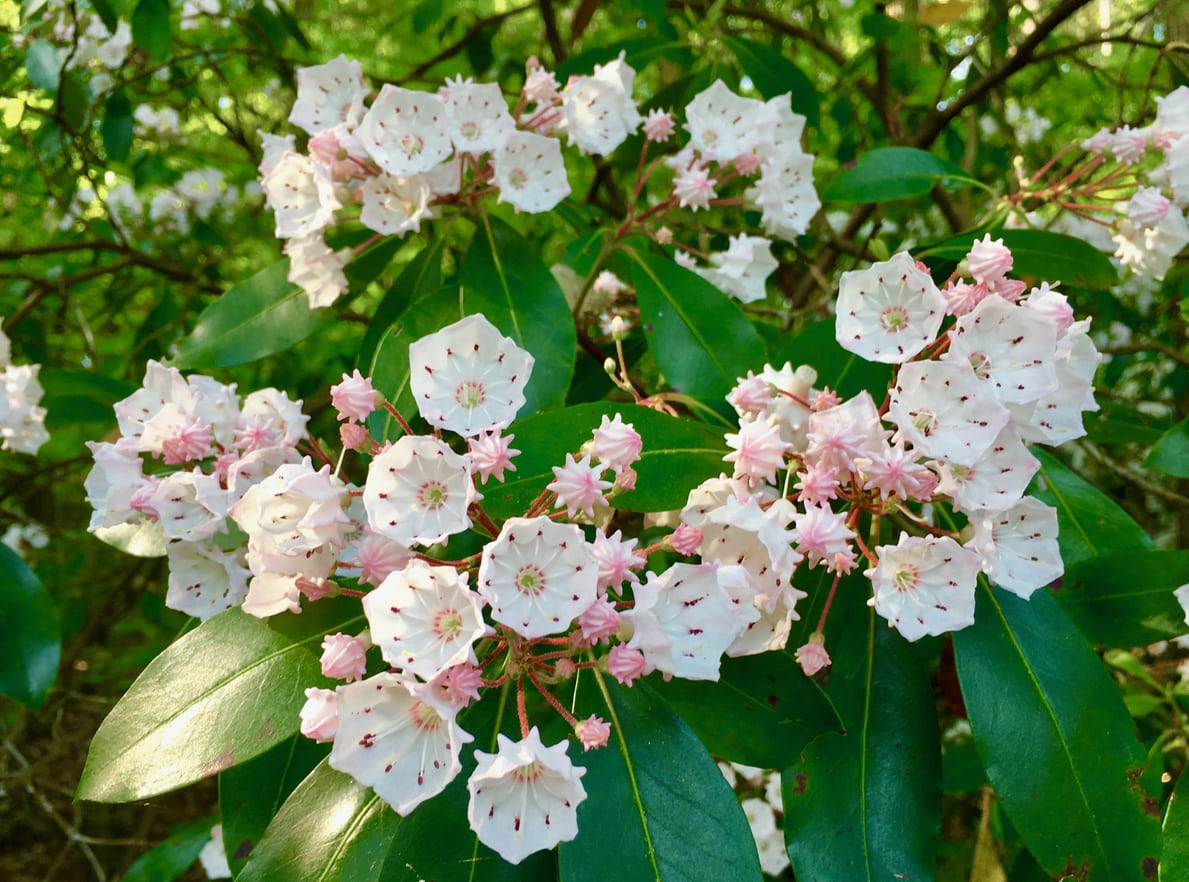 Mountain Laurel www.gardeningknowhow.com
Mountain Laurel www.gardeningknowhow.com
Mountain laurel (Kalmia latifolia)
It's not hard to see why Pennsylvania and Connecticut claimed this to be their state flower! This evergreen boasts absolutely stunning flowers in late spring into summer. Bees, butterflies, and hummingbirds will frequent these flowers when they are in bloom. The foliage is toxic to many animals, but white tailed deer will browse the leaves during winter and early spring when other food sources are low. This plant is highly resistant to any damage caused by deer; it's not likely to cause any problems with the growth!
 Oakleaf Hydrangea www.fast-growing-trees.com
Oakleaf Hydrangea www.fast-growing-trees.com
Oakleaf Hydrangea (Hydrangea quercifolia)
Oakleaf hydrangea are criminally underused in the landscape. They provide an absolutely stunning fall color. Not only that, but the flowers will begin white and slowly turn pink as the season wears on. They are one of the most shade tolerant of hydrangeas, making them very versatile in the landscape. Pollinators are attracted to the large blooms and the seeds are consumed by songbirds. Songbirds may also nest in the shrub, as the large leaves provide heavy cover for the chicks.
Of course, we all love some perennials with their pops of color that bring spring, summer and fall color into our gardens!
 Helenium autumnale photographed by Gina DellaSalla
Helenium autumnale photographed by Gina DellaSalla
Sneezeweed/Helen's flower (Helenium autumnale)
This is one of the few plants that is native across the entire United States. While the common name may already make your nose itch, this plant isn't linked to fall allergies! The pollen grains are transported to other flowers by insects, rather than wind, so it's unlikely for this plant to aggrevate your sinuses. Instead, this plant got its name from the fact that it was used by indigenous people to treat colds. It flowers prolifically in fall when other plants have long ended their display for the season. So while this will bring beauty to the landscape, it will also bring lots of hard to find food for pollinators. Bees and butterflies will frequent this flower. It should be a staple in any pollinator garden!
 Heliopsis helianthoides photographed by Gina DellaSalla
Heliopsis helianthoides photographed by Gina DellaSalla
False Sunflower (Heliopsis helianthoides)
Another plant with prolific flowers that pollinators love, false sunflower will bloom from spring through summer and potentially into fall. Pollinators such as bees and butterflies will frequent the flowers while in bloom. Once the flowers begin producing seeds, small songbirds like chickadees and goldfinches will stop by for a snack. This plant sets seeds sooner than other native flowers that these birds also visit, like purple coneflowers. Planting both will help our native birds and pollinators much longer than one or the other.
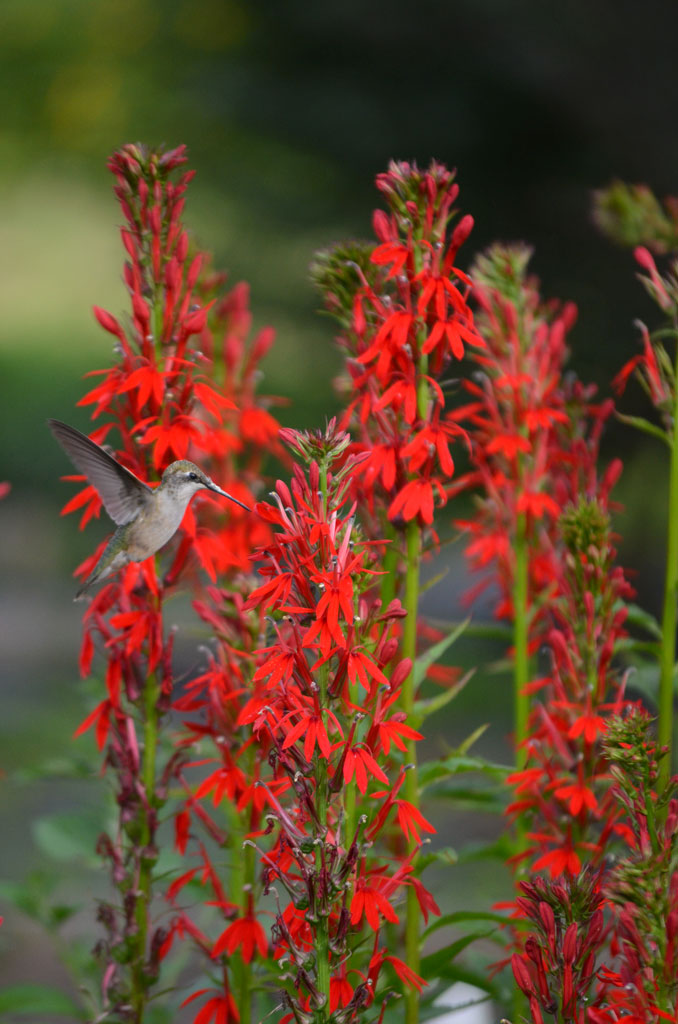 Lobelia cardinalis www.prairiemoon.com
Lobelia cardinalis www.prairiemoon.com
Cardinal Flower (Lobelia cardinalis)
Like most lobelia, this species is herbivore resistant due to a chemical compound called lobeline. The flowers are frequented by hummingbirds and butterflies, but will also attract bees. Lobelia thrives in wet, sunny areas of the lawn and would make a wonderful addition to rain gardens and pollinator gardens alike.
 Virginia Bluebells hgic.clemson.edu
Virginia Bluebells hgic.clemson.edu
Virginia Bluebells (Mertensia virginica)
Virginia bluebells are a spring ephemeral, meaning they complete their life cycle during the springtime before the trees leaf out. They will go dormant once again in mid summer. While their presence may be fleeting, their beauty is impeccable. They are threatened with extinction in their native range, primarily due to habitat loss. These are one of the first plants to bloom in spring, making it a valuable resource for the pollinators that visit it. The flowers are primarily pollinated by bumblebees, hummingbirds, butterflies, hummingbird moths, bee flies and several more native pollinators. They are an impeccable addition to any wet, shady area and your local pollinators will thank you!
Adding native plants to your landscape is an easy way to help combat habitat loss, conserve water, and help your local wildlife. Native plants are much lower maintenance than that of other popular non-native plants we tend to gravitate towards. While by no means do you have to rip out your landscape and start over, even adding a few native plants will help bring natural beauty, pollinators, and wildlife to your landscape.
Happy growing!!
<3 Gina
Works Cited
Lobelia cardinalis - cardinal flower. Prairie Moon Nursery. (n.d.). Retrieved May 16, 2022, from https://www.prairiemoon.com/lobelia-cardinalis-cardinal-flower-prairie-moon-nursery.html
North Carolina Extension. Home | North Carolina Extension Gardener Plant Toolbox. (n.d.). Retrieved May 16, 2022, from https://plants.ces.ncsu.edu/
The Pennsylvania State University. Penn State Extension. (n.d.). Retrieved May 16, 2022, from https://extension.psu.edu/
Richardson, L. L., Bowers, M. D., & Irwin, R. E. (2016). Nectar chemistry mediates the behavior of parasitized bees: Consequences for plant fitness. Ecology, 97(2), 325–337. https://doi.org/10.1890/15-0263.1
susan.mahr, W. by. (n.d.). Virginia bluebells, mertensia virginica. Wisconsin Horticulture. Retrieved May 16, 2022, from https://hort.extension.wisc.edu/articles/virginia-bluebells-mertensia-virginica/
